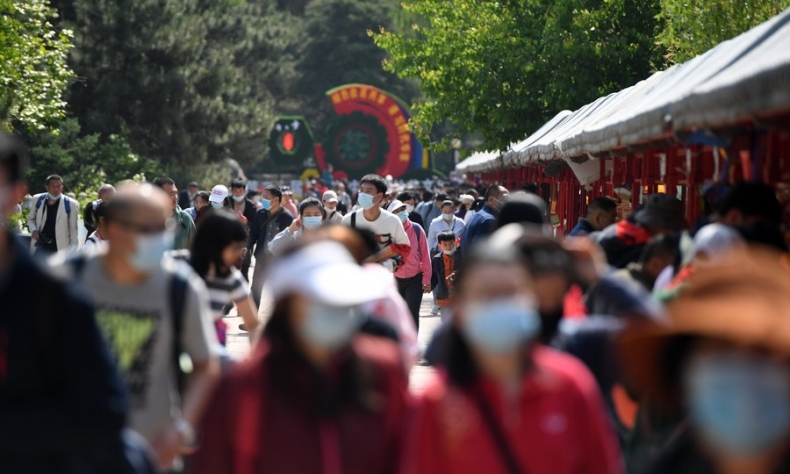Does a Falling Birth Rate Equal ‘Genocide’?

The decline in birth rates in Xinjiang, as is the case in the U.S., is the result of socio-economic development and an improvement in the status of women.
“Quick, someone get Adrian Zenz on the phone! To investigate and see if ‘genocide’ is taking place in the U.S.” Readers were joking in the comment sections of several Western media outlets in response to reports covering the declining birth rate in the U.S. A drop in birth rates was in fact one of Zenz’s main reasons underpinning his claim that “genocide” occurred in China’s Xinjiang region.
According to a report released by the U.S. Centers for Disease Control and Prevention (CDC) on May 5, the number of births in the country in 2020 fell by 4 percent from the previous year, hitting a new record low since 1979. In fact, since 2007, the U.S. has remained below the fertility replacement level, meaning on a daily average there are more people leaving this world than coming into it. In 2019, the website of the American Embassy in China published an article in standard Chinese explaining that the decline in birth rates, in an attempt to rationalize the phenomenon, “is common all over the world, especially in developed countries.”
However, this “common phenomenon” in the specific case of Xinjiang has been taken on to serve as criminal evidence of the alleged “genocide” committed by the Communist Party of China (CPC) against the Uygurs. Zenz formulated this as the core of his argument against China when he found from public data that the birth rate in Xinjiang had been falling.
Zenz claimed that the CPC had confined Uygur women who violated the fertility policy to “concentration camps” and forced them to undergo sterilization. The absurdity of such an argument is that in this digital era, human rights abuse on such a grand scale cannot fly under the radar, and Zenz each and every time has only one and the same group of alleged victims to call to the stand.
So what happened in Xinjiang to cause this drop in the birth rate?
One of the more direct underlying reasons is the rise in employment opportunities for Uygur women in recent years. In order to forge an accurate reference framework here, one must bear in mind the region’s geographical divide. South Xinjiang, with a majority Uygur population, has been a relatively poor region in China. Early marriage and childbearing have been common in the area due to its limited transport, lagging economic development and lower education levels—compared to those in other regions.
In order to achieve its poverty alleviation goals, the government has encouraged women from poverty-stricken areas to obtain employment in cities. In 2017 alone, state-owned enterprises in Xinjiang created more than 10,000 jobs in the Kashgar and Hotan regions. The move attracted many young Uygur women. For these women who might otherwise get married and give birth at a very early age, the choice of working outside the home has opened up a host of new horizons.
Nevertheless, often when these young women set out to seek employment outside their hometowns, they are met with resistance from senior generations who do not support their choice to venture outside into the workplace. In reality, though, today’s rural Xinjiang daughters often disagree with their parents’ notions on life choices. The new generation, born after 1995, is more independent and eager to realize their sense of self-actualization.
Furthermore, one must take into account the changes in social background currently making waves across the Xinjiang region. Xinjiang has managed to maintain robust social and economic development. The per-capita disposable income of rural residents increased from 9,425 yuan ($1,450) in 2015 to 13,122 yuan ($2,018) in 2019, displaying an average annual growth of more than 8 percent. In general, birth rates closely relate to the level of economic development, and subsequently tend to be higher in developing countries than in developed countries.
Then we get to the topic of education equality, another strong factor in global birth rate scenarios. Rule of thumb: the higher the women’s education level, the lower fertility rates will be. Both the number and percentage of women receiving higher education swelled considerably in Xinjiang during the two decades spanning from 1998 to 2018. The proportion of the female population who had obtained a university degree (or above) in Xinjiang went from 5.07 percent in 1998 to 17.63 percent in 2018. As more and more Uygur women today pursue higher education, they tend to put the themes of marriage and starting a family on the backburner.
The decline in birth rates in Xinjiang, as is the case in the U.S., is the result of socio-economic development and an improvement in the status of women. Nonetheless, for those bent on attacking China, the moment China admits the Uygur birth rate has declined, they will always insist that the area’s Uygur population is suffering a fate akin to the Nazi persecution of the Jews in World War II. Rates rationale or no rationale?
 Facebook
Facebook
 Twitter
Twitter
 Linkedin
Linkedin
 Google +
Google +










